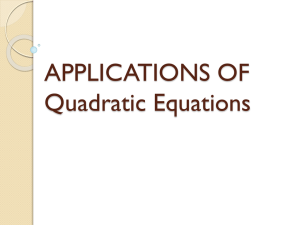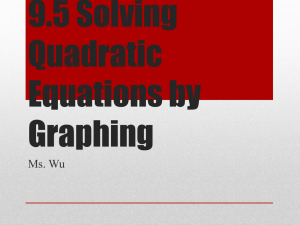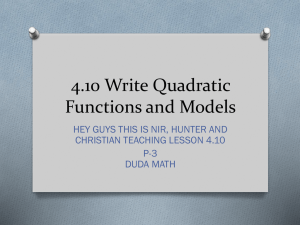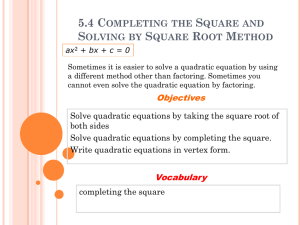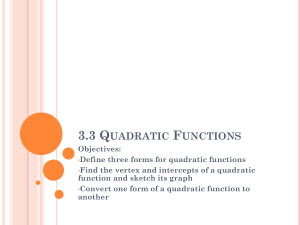Holt Algebra 2 5-1
advertisement
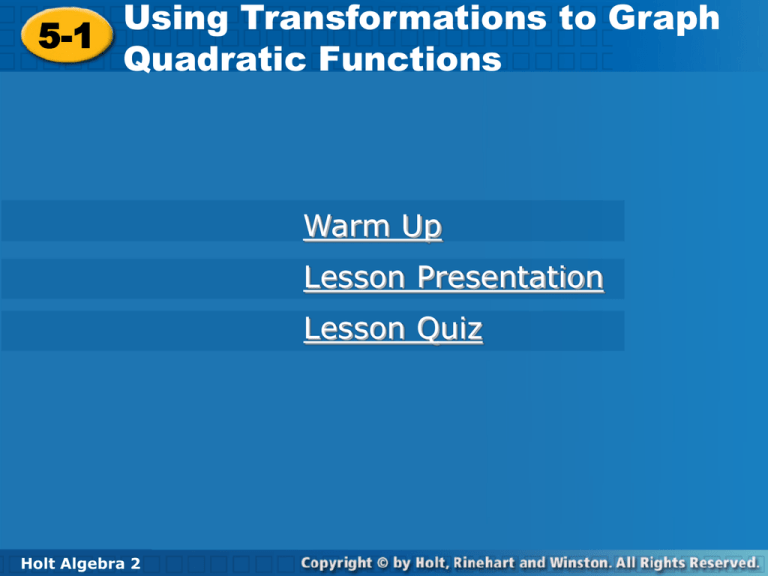
Using Transformations to Graph Using Transformations to Graph 5-1 5-1 Quadratic Functions Quadratic Functions Warm Up Lesson Presentation Lesson Quiz Holt Algebra Holt Algebra 22 5-1 Using Transformations to Graph Quadratic Functions Warm Up For each translation of the point (–2, 5), give the coordinates of the translated point. 1. 6 units down (–2, –1) 2. 3 units right (1, 5) For each function, evaluate f(–2), f(0), and f(3). 3. f(x) = x2 + 2x + 6 6; 6; 21 4. f(x) = 2x2 – 5x + 1 19; 1; 4 Holt Algebra 2 5-1 Using Transformations to Graph Quadratic Functions Objectives Transform quadratic functions. Describe the effects of changes in the coefficients of y = a(x – h)2 + k. Holt Algebra 2 5-1 Using Transformations to Graph Quadratic Functions Notice that the graph of the parent function f(x) = x2 is a U-shaped curve called a parabola. As with other functions, you can graph a quadratic function by plotting points with coordinates that make the equation true. Holt Algebra 2 5-1 Using Transformations to Graph Quadratic Functions You can also graph quadratic functions by applying transformations to the parent function f(x) = x2. Transforming quadratic functions is similar to transforming linear functions (Lesson 2-6). Holt Algebra 2 5-1 Using Transformations to Graph Quadratic Functions Example 1A: Translating Quadratic Functions Use the graph of f(x) = x2 as a guide, describe the transformations and then graph each function. g(x) = (x – 2)2 + 4 Identify h and k. g(x) = (x – 2)2 + 4 h k Because h = 2, the graph is translated 2 units right. Because k = 4, the graph is translated 4 units up. Therefore, g is f translated 2 units right and 4 units up. Holt Algebra 2 5-1 Using Transformations to Graph Quadratic Functions Example 2B: Translating Quadratic Functions Use the graph of f(x) = x2 as a guide, describe the transformations and then graph each function. g(x) = (x + 2)2 – 3 Holt Algebra 2 5-1 Using Transformations to Graph Quadratic Functions Holt Algebra 2 5-1 Using Transformations to Graph Quadratic Functions Example 3A: Reflecting, Stretching, and Compressing Quadratic Functions Using the graph of f(x) = x2 as a guide, describe the transformations and then graph each function. g (x ) =- 1 x 4 2 Because a is negative, g is a reflection of f across the x-axis. Because |a| = , g is a vertical compression of f by a factor of . Holt Algebra 2 5-1 Using Transformations to Graph Quadratic Functions Example 3B: Reflecting, Stretching, and Compressing Quadratic Functions Using the graph of f(x) = x2 as a guide, describe the transformations and then graph each function. g(x) =(3x)2 Because b = , g is a horizontal compression of f by a factor of . Holt Algebra 2 5-1 Using Transformations to Graph Quadratic Functions Check It Out! Example 3a Using the graph of f(x) = x2 as a guide, describe the transformations and then graph each function. g(x) =(2x)2 Because b = , g is a horizontal compression of f by a factor of . Holt Algebra 2 5-1 Using Transformations to Graph Quadratic Functions Check It Out! Example 3b Using the graph of f(x) = x2 as a guide, describe the transformations and then graph each function. g(x) = – x2 Because a is negative, g is a reflection of f across the x-axis. Because |a| = , g is a vertical compression of f by a factor of . Holt Algebra 2 5-1 Using Transformations to Graph Quadratic Functions If a parabola opens upward, it has a lowest point. If a parabola opens downward, it has a highest point. This lowest or highest point is the vertex of the parabola. The parent function f(x) = x2 has its vertex at the origin. You can identify the vertex of other quadratic functions by analyzing the function in vertex form. The vertex form of a quadratic function is f(x) = a(x – h)2 + k, where a, h, and k are constants. Holt Algebra 2 5-1 Using Transformations to Graph Quadratic Functions Because the vertex is translated h horizontal units and k vertical from the origin, the vertex of the parabola is at (h, k). Holt Algebra 2 5-1 Using Transformations to Graph Quadratic Functions Example 4: Writing Transformed Quadratic Functions Use the description to write the quadratic function in vertex form. The parent function f(x) = x2 is vertically stretched by a factor of and then translated 2 units left and 5 units down to create g. g(x) = a(x – h)2 + k Holt Algebra 2 5-1 Using Transformations to Graph Quadratic Functions Check It Out! Example 4a Use the description to write the quadratic function in vertex form. The parent function f(x) = x2 is vertically compressed by a factor of and then translated 2 units right and 4 units down to create g. g(x) = a(x – h)2 + k Holt Algebra 2 5-1 Using Transformations to Graph Quadratic Functions Check It Out! Example 4b Use the description to write the quadratic function in vertex form. The parent function f(x) = x2 is reflected across the x-axis and translated 5 units left and 1 unit up to create g. g(x) = a(x – h)2 + k Holt Algebra 2 5-1 Using Transformations to Graph Quadratic Functions Lesson Quiz: Part I 1. Graph f(x) = x2 + 3x – 1 by using a table. Holt Algebra 2 5-1 Using Transformations to Graph Quadratic Functions Lesson Quiz: Part II 2. Using the graph of f(x) = x2 as a guide, describe the transformations, and then graph g(x) = (x + 1)2. g is f reflected across x-axis, vertically compressed by a factor of , and translated 1 unit left. Holt Algebra 2 5-1 Using Transformations to Graph Quadratic Functions Lesson Quiz: Part III 3. The parent function f(x) = x2 is vertically stretched by a factor of 3 and translated 4 units right and 2 units up to create g. Write g in vertex form. g(x) = 3(x – 4)2 + 2 Holt Algebra 2




